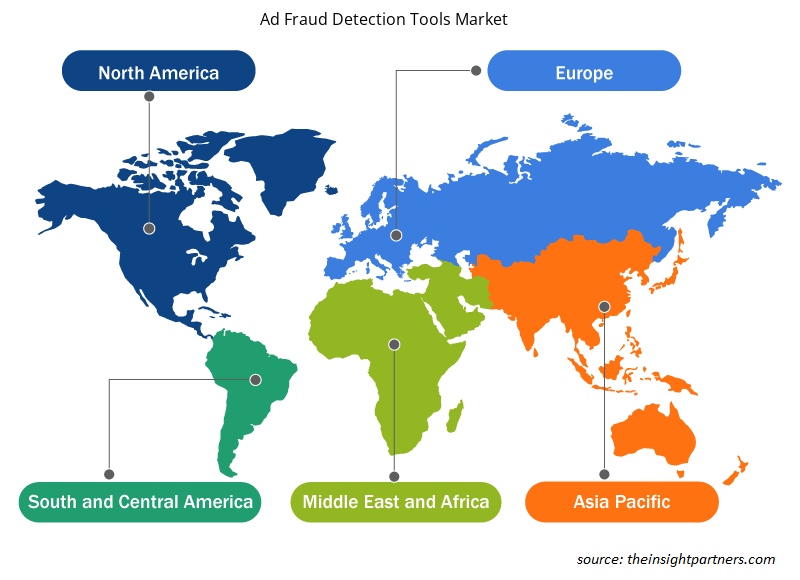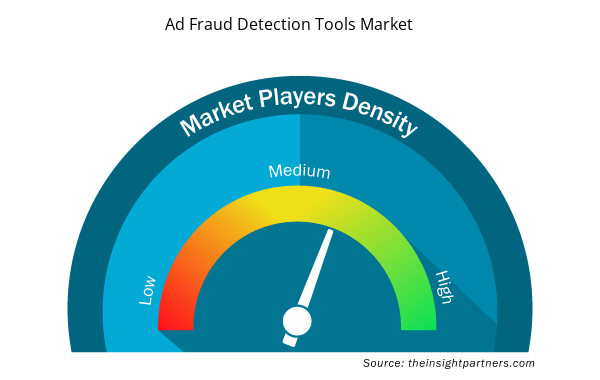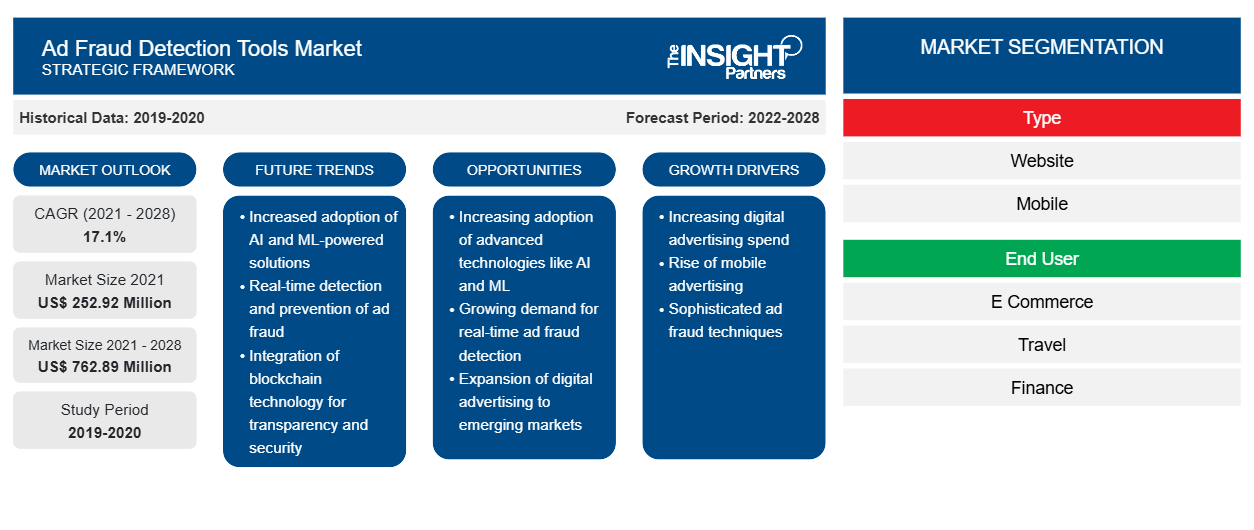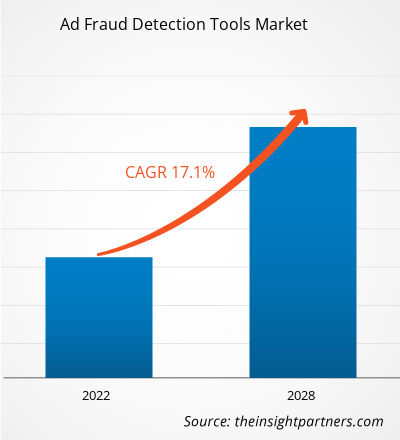[Informe de investigación] Se espera que el mercado de herramientas de detección de fraude publicitario crezca de US$ 252,92 millones en 2021 a US$ 762,89 millones en 2028; se estima que crecerá a una CAGR del 17,1% durante 2021 a 2028.
Con el creciente número de usuarios de Internet, la demanda de publicidad digital está aumentando debido a varias plataformas digitales para publicidad. La publicidad digital ahora es más sofisticada, personalizada y relevante. Los consumidores pasan más tiempo en línea que nunca, y la publicidad digital ofrece una forma ideal de llegar a los consumidores multidispositivo y multicanal. Los vendedores también pueden dirigirse a los consumidores con una precisión enfocada como nunca antes. Las marcas ya no se limitan solo a la demografía y la firmografía, sino que pueden dirigirse a la audiencia exacta con más probabilidades de comprar en función de miles de variables de segmentación de estilo de vida, personalidad, comportamientos e intención de compra. El móvil es el principal impulsor del crecimiento de la publicidad digital en la actualidad, representando más del 70% de los gastos digitales y más de una cuarta parte del total de los medios de comunicación, según los datos del sitio web V12. Además, los estadounidenses pasan más de 10 horas al día frente a las pantallas, y aproximadamente cinco de esas horas las pasan en sus teléfonos inteligentes.
La llegada de la publicidad digital ha provocado un aumento del fraude publicitario digital y también ha provocado muchas pérdidas de ingresos para las empresas. Por ejemplo, se estima que el fraude publicitario digital costará a las marcas alrededor de 44.000 millones de dólares en actividades fraudulentas para 2022 y alcanzará hasta el 45% del total gastado, según datos de mFilterIt de noviembre de 2021. Además, los estafadores están desarrollando continuamente tecnologías para engañar al ecosistema, mientras que las empresas de tecnología están en constante evolución para encontrar formas de detener a estos estafadores. Por lo tanto, para evitar que estos fraudes publicitarios ocurran con las marcas y los anunciantes, empresas como mFilterIt ofrecen soluciones integrales para los fraudes publicitarios digitales. La solución utiliza algoritmos complejos para monitorear activamente los espacios web superficiales y oscuros y luego, utilizando inteligencia artificial y aprendizaje automático , convertirlos en informes significativos y procesables que ayudan a los custodios de las marcas y a los propietarios de las comunidades a protegerse de forma proactiva de cualquier daño potencial a la identidad y privacidad de los miembros de su comunidad. Por lo tanto, con el aumento de los anuncios digitales, las actividades fraudulentas en la publicidad digital están aumentando, lo que impulsa la necesidad de herramientas de detección de fraude publicitario a nivel mundial.
Personalice este informe según sus necesidades
Obtendrá personalización en cualquier informe, sin cargo, incluidas partes de este informe o análisis a nivel de país, paquete de datos de Excel, así como también grandes ofertas y descuentos para empresas emergentes y universidades.
- Obtenga las principales tendencias clave del mercado de este informe.Esta muestra GRATUITA incluirá análisis de datos, desde tendencias del mercado hasta estimaciones y pronósticos.
Impacto de la pandemia de COVID-19 en el mercado global de herramientas de detección de fraude publicitario
En 2020, con el escenario del brote de COVID-19, el bloqueo nacional de todos y cada uno de los países ha aumentado el alcance del mercado de las tecnologías digitales. Un mayor número de personas ahora utilizan una o varias plataformas digitales por varias razones, como el trabajo desde casa (WFH), las transacciones en línea a través de las aplicaciones digitales de sus bancos o mediante billeteras de dinero móviles/digitales. Y con esto, los fraudes publicitarios también están aumentando con un solo clic. Esto ha provocado varias pérdidas de ingresos para la empresa. Por ejemplo, los datos de matchseries.com muestran que las pérdidas globales por fraude publicitario en 2020 alcanzaron un total de US$ 35 mil millones, mientras que un informe de Campaign Asia publicado en diciembre de 2020 encontró que el fraude publicitario está robando el 20% del gasto publicitario en línea del mundo. Estas cifras ayudan a ilustrar el alcance del problema que crea el fraude publicitario para las empresas, y la amplia gama de diferentes plataformas y opciones publicitarias que están disponibles para las empresas significa que el nivel de desperdicio puede variar considerablemente. No son solo las pymes las que caen víctimas de cantidades tan significativas de tráfico fraudulento, sino que muchas de las empresas más grandes del mundo también se ven afectadas. Por lo tanto, las herramientas de detección de fraude publicitario también han sido adoptadas por más empresas. Por lo tanto, el mercado global de herramientas de detección de fraude publicitario tuvo un crecimiento positivo en 2020.
Perspectivas del mercado de herramientas de detección de fraude publicitario
Aumento del uso de IA y ML para impulsar el mercado de herramientas de detección de fraude publicitario durante el período de pronóstico
El uso de inteligencia artificial (IA) y aprendizaje automático (ML) ayuda a abordar los últimos tipos de fraudes publicitarios gracias a las capacidades de autoaprendizaje. El sistema de detección de fraudes impulsado por IA sigue un algoritmo de ML que ayuda al sistema a aprender de actividades sospechosas (clics, ubicaciones de anuncios) y crea capas de protección. Este tipo de sistema no solo mejora y se adapta para abordar los últimos tipos de fraudes publicitarios, sino que también puede reconocer patrones en un conjunto de puntos de datos mucho más amplio que los sistemas tradicionales. En promedio, un sistema de detección de fraudes basado en IA (ML) puede analizar más de 80 dimensiones a la vez y puede detectar incluso los fraudes publicitarios más sofisticados, como el fraude publicitario de Methbot.
Mercado de herramientas de detección de fraude publicitario: información sobre el mercado basada en tipos
Según el tipo, el mercado de herramientas de detección de fraude publicitario se divide en sitios web y dispositivos móviles. En 2021, el segmento de dispositivos móviles lideró el mercado de herramientas de detección de fraude publicitario y representó una mayor participación de mercado.
Mercado de herramientas de detección de fraude publicitario: información del mercado basada en el usuario final
Según el usuario final, el mercado de herramientas de detección de fraude publicitario se segmenta en comercio electrónico, viajes, finanzas, juegos y otros. En 2021, el segmento financiero lideró el mercado de herramientas de detección de fraude publicitario y representó la mayor participación de mercado.
Los actores que operan en el mercado de herramientas de detección de fraude publicitario adoptan estrategias como fusiones, adquisiciones e iniciativas de mercado para mantener sus posiciones en el mercado. A continuación, se enumeran algunos de los desarrollos de los actores clave:
- En febrero de 2021, Applovin Corporation adquirió Adjust GmbH. Esta adquisición ofrecerá las mejores soluciones en un solo paquete, poniendo las soluciones de medición, análisis, crecimiento y monetización al alcance de todos los desarrolladores de aplicaciones en todo el mundo.
- En febrero de 2020, App Samurai Inc. (plataforma de crecimiento móvil) logró una inversión de 2,4 millones de dólares en una ronda de financiación liderada por 212 empresas, con Collective Spark, 500 startups y Degerhan Usluel, lo que elevó la inversión total a 4,6 millones de dólares. App Samurai utilizará la financiación para desarrollar su cartera de productos y trabajar hacia la expansión global.
Perspectivas regionales del mercado de herramientas de detección de fraude publicitario
Los analistas de Insight Partners explicaron en detalle las tendencias y los factores regionales que influyen en el mercado de herramientas de detección de fraude publicitario durante el período de pronóstico. Esta sección también analiza los segmentos y la geografía del mercado de herramientas de detección de fraude publicitario en América del Norte, Europa, Asia Pacífico, Oriente Medio y África, y América del Sur y Central.

- Obtenga datos regionales específicos para el mercado de herramientas de detección de fraude publicitario
Alcance del informe de mercado sobre herramientas de detección de fraude publicitario
| Atributo del informe | Detalles |
|---|---|
| Tamaño del mercado en 2021 | US$ 252,92 millones |
| Tamaño del mercado en 2028 | US$ 762,89 millones |
| CAGR global (2021-2028) | 17,1% |
| Datos históricos | 2019-2020 |
| Período de pronóstico | 2022-2028 |
| Segmentos cubiertos | Por tipo
|
| Regiones y países cubiertos | América del norte
|
| Líderes del mercado y perfiles de empresas clave |
|
Densidad de actores del mercado de herramientas de detección de fraude publicitario: comprensión de su impacto en la dinámica empresarial
El mercado de herramientas de detección de fraude publicitario está creciendo rápidamente, impulsado por la creciente demanda de los usuarios finales debido a factores como la evolución de las preferencias de los consumidores, los avances tecnológicos y una mayor conciencia de los beneficios del producto. A medida que aumenta la demanda, las empresas amplían sus ofertas, innovan para satisfacer las necesidades de los consumidores y aprovechan las tendencias emergentes, lo que impulsa aún más el crecimiento del mercado.
La densidad de actores del mercado se refiere a la distribución de las empresas o firmas que operan dentro de un mercado o industria en particular. Indica cuántos competidores (actores del mercado) están presentes en un espacio de mercado determinado en relación con su tamaño o valor total de mercado.
Las principales empresas que operan en el mercado de herramientas de detección de fraude publicitario son:
- AplicacionesFlyer Ltd.
- Ajuste GmbH
- Métricas de sucursales, Inc.
- Puntuación de fraude
- Interceptado (App Samurai Inc.)
Descargo de responsabilidad : Las empresas enumeradas anteriormente no están clasificadas en ningún orden particular.

- Obtenga una descripción general de los principales actores clave del mercado de herramientas de detección de fraude publicitario
Perfiles de empresas
- AplicacionesFlyer Ltd.
- Ajuste GmbH
- Métricas de sucursales, Inc.
- Puntuación de fraude
- Interceptado (App Samurai Inc.)
- Publicidad en máquinas limitada
- Realizar[cb], LLC
- Empresa Scalarr Inc.
- Laboratorios Singulares, Inc.
- TrafficGuard Pty Ltd
- ADEX (Empresas Samoukale Limitada)
- Análisis histórico (2 años), año base, pronóstico (7 años) con CAGR
- Análisis PEST y FODA
- Tamaño del mercado Valor/volumen: global, regional, nacional
- Industria y panorama competitivo
- Conjunto de datos de Excel


- Frozen Potato Market
- Queue Management System Market
- Flexible Garden Hoses Market
- Joint Pain Injection Market
- Formwork System Market
- Analog-to-Digital Converter Market
- Carbon Fiber Market
- Antibiotics Market
- Electronic Signature Software Market
- Health Economics and Outcome Research (HEOR) Services Market

Report Coverage
Revenue forecast, Company Analysis, Industry landscape, Growth factors, and Trends

Segment Covered
This text is related
to segments covered.

Regional Scope
North America, Europe, Asia Pacific, Middle East & Africa, South & Central America

Country Scope
This text is related
to country scope.
Preguntas frecuentes
Growth in Managing & Monitoring Advertising Campaigns
Surge in Digital Advertisement
Ad fraud detection tools are increasingly adopted by SMEs due to the growing number of small and medium businesses are shifting focus toward online marketing, such as social media marketing. Fraudsters are seeing an influx of new and often unaware digital properties as prey, with more small-to-medium enterprises (SMEs) shifting marketing efforts toward digital platforms. Further, the number of start-ups is increasing across the globe. Therefore, the rising number of SMEs across the globe focusing toward online marketing creates a lucrative opportunity for ad fraud detection tools market players..
On the basis of type, the ad fraud detection tools market is segmented into website and mobile. Ad frauds are the act of generating revenue using fraudulent digital advertising techniques. Usually, this is categorized into two broad terms: desktop (website) and mobile ad frauds. With an increasing number of mobile users globally and less protection on mobile devices, fraudulent activities are more observed on mobile devices. And with larger mobile ad fraud detection & prevention tools, the mobile segment dominates the market.
Key companies in the ad fraud detection tools market include Adjust GmbH; AppsFlyer Ltd.; Branch Metrics, Inc.; FraudScore; Interceptd (App Samurai Inc.); Machine Advertising Limited; Perform[cb], LLC; Scalarr Inc.; Singular Labs, Inc.; TrafficGuard Pty Ltd; and ADEX (Samoukale Enterprises Limited).
The usage of artificial intelligence (AI) and machine learning (ML) helps tackle the latest kinds of ad frauds due to self-learning capabilities. AI-powered fraud detection system follows a ML algorithm that helps the system learn from suspicious activities (clicks, ad placements) and builds layers of protection.
North America held the largest market share in year 2020, along with the notable revenue generation opportunities in Europe and APAC.
Trends and growth analysis reports related to Technology, Media and Telecommunications : READ MORE..
The List of Companies - Ad Fraud Detection Tools Market
- AppsFlyer Ltd.
- Adjust GmbH
- Branch Metrics, Inc.
- FraudScore
- Interceptd (App Samurai Inc.)
- Machine Advertising Limited
- Perform[cb], LLC
- Scalarr Inc.
- Singular Labs, Inc.
- TrafficGuard Pty Ltd
- ADEX (Samoukale Enterprises Limited)
The Insight Partners performs research in 4 major stages: Data Collection & Secondary Research, Primary Research, Data Analysis and Data Triangulation & Final Review.
- Data Collection and Secondary Research:
As a market research and consulting firm operating from a decade, we have published and advised several client across the globe. First step for any study will start with an assessment of currently available data and insights from existing reports. Further, historical and current market information is collected from Investor Presentations, Annual Reports, SEC Filings, etc., and other information related to company’s performance and market positioning are gathered from Paid Databases (Factiva, Hoovers, and Reuters) and various other publications available in public domain.
Several associations trade associates, technical forums, institutes, societies and organization are accessed to gain technical as well as market related insights through their publications such as research papers, blogs and press releases related to the studies are referred to get cues about the market. Further, white papers, journals, magazines, and other news articles published in last 3 years are scrutinized and analyzed to understand the current market trends.
- Primary Research:
The primarily interview analysis comprise of data obtained from industry participants interview and answers to survey questions gathered by in-house primary team.
For primary research, interviews are conducted with industry experts/CEOs/Marketing Managers/VPs/Subject Matter Experts from both demand and supply side to get a 360-degree view of the market. The primary team conducts several interviews based on the complexity of the markets to understand the various market trends and dynamics which makes research more credible and precise.
A typical research interview fulfils the following functions:
- Provides first-hand information on the market size, market trends, growth trends, competitive landscape, and outlook
- Validates and strengthens in-house secondary research findings
- Develops the analysis team’s expertise and market understanding
Primary research involves email interactions and telephone interviews for each market, category, segment, and sub-segment across geographies. The participants who typically take part in such a process include, but are not limited to:
- Industry participants: VPs, business development managers, market intelligence managers and national sales managers
- Outside experts: Valuation experts, research analysts and key opinion leaders specializing in the electronics and semiconductor industry.
Below is the breakup of our primary respondents by company, designation, and region:

Once we receive the confirmation from primary research sources or primary respondents, we finalize the base year market estimation and forecast the data as per the macroeconomic and microeconomic factors assessed during data collection.
- Data Analysis:
Once data is validated through both secondary as well as primary respondents, we finalize the market estimations by hypothesis formulation and factor analysis at regional and country level.
- Macro-Economic Factor Analysis:
We analyse macroeconomic indicators such the gross domestic product (GDP), increase in the demand for goods and services across industries, technological advancement, regional economic growth, governmental policies, the influence of COVID-19, PEST analysis, and other aspects. This analysis aids in setting benchmarks for various nations/regions and approximating market splits. Additionally, the general trend of the aforementioned components aid in determining the market's development possibilities.
- Country Level Data:
Various factors that are especially aligned to the country are taken into account to determine the market size for a certain area and country, including the presence of vendors, such as headquarters and offices, the country's GDP, demand patterns, and industry growth. To comprehend the market dynamics for the nation, a number of growth variables, inhibitors, application areas, and current market trends are researched. The aforementioned elements aid in determining the country's overall market's growth potential.
- Company Profile:
The “Table of Contents” is formulated by listing and analyzing more than 25 - 30 companies operating in the market ecosystem across geographies. However, we profile only 10 companies as a standard practice in our syndicate reports. These 10 companies comprise leading, emerging, and regional players. Nonetheless, our analysis is not restricted to the 10 listed companies, we also analyze other companies present in the market to develop a holistic view and understand the prevailing trends. The “Company Profiles” section in the report covers key facts, business description, products & services, financial information, SWOT analysis, and key developments. The financial information presented is extracted from the annual reports and official documents of the publicly listed companies. Upon collecting the information for the sections of respective companies, we verify them via various primary sources and then compile the data in respective company profiles. The company level information helps us in deriving the base number as well as in forecasting the market size.
- Developing Base Number:
Aggregation of sales statistics (2020-2022) and macro-economic factor, and other secondary and primary research insights are utilized to arrive at base number and related market shares for 2022. The data gaps are identified in this step and relevant market data is analyzed, collected from paid primary interviews or databases. On finalizing the base year market size, forecasts are developed on the basis of macro-economic, industry and market growth factors and company level analysis.
- Data Triangulation and Final Review:
The market findings and base year market size calculations are validated from supply as well as demand side. Demand side validations are based on macro-economic factor analysis and benchmarks for respective regions and countries. In case of supply side validations, revenues of major companies are estimated (in case not available) based on industry benchmark, approximate number of employees, product portfolio, and primary interviews revenues are gathered. Further revenue from target product/service segment is assessed to avoid overshooting of market statistics. In case of heavy deviations between supply and demand side values, all thes steps are repeated to achieve synchronization.
We follow an iterative model, wherein we share our research findings with Subject Matter Experts (SME’s) and Key Opinion Leaders (KOLs) until consensus view of the market is not formulated – this model negates any drastic deviation in the opinions of experts. Only validated and universally acceptable research findings are quoted in our reports.
We have important check points that we use to validate our research findings – which we call – data triangulation, where we validate the information, we generate from secondary sources with primary interviews and then we re-validate with our internal data bases and Subject matter experts. This comprehensive model enables us to deliver high quality, reliable data in shortest possible time.


 Obtenga una muestra gratuita de este informe
Obtenga una muestra gratuita de este informe